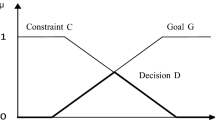Abstract
This paper deals with development of a seasonal fraction-removal policy model for waste load allocation in streams addressing uncertainties due to randomness and fuzziness. A stochastic dynamic programming (SDP) model is developed to arrive at the steady-state seasonal fraction-removal policy. A fuzzy decision model (FDM) developed by us in an earlier study is used to compute the system performance measure required in the SDP model. The state of the system in a season is defined by streamflows at the headwaters during the season and the initial DO deficit at some pre-specified checkpoints. The random variation of streamflows is included in the SDP model through seasonal transitional probabilities. The decision vector consists of seasonal fraction-removal levels for the effluent dischargers. Uncertainty due to imprecision (fuzziness) associated with water quality goals is addressed using the concept of fuzzy decision. Responses of pollution control agencies to the resulting end-of-season DO deficit vector and that of dischargers to the fraction-removal levels are treated as fuzzy, and modelled with appropriate membership functions. Application of the model is illustrated with a case study of the Tungabhadra river in India.
Similar content being viewed by others
References
Bellman R E, Zadeh L A 1970 Decision-making in a fuzzy environment.Manage. Sci. B17: 141–164
Burn D H 1989 Water-quality management through combined simulation-optimization approach.J. Environ. Eng., ASCE 115: 1011–1024
Burn D H, Lence B J 1992 Comparison of optimization formulations for waste-load allocations.J. Environ. Eng., ASCE 118: 597–612
Burn D H, McBean E A 1985 Optimization modeling of water quality in an uncertain environment.Water Resources Res. 21: 934–940
Burn D H, McBean E A1986 Linear stochastic optimization applied to biochemical oxygen demand — Dissolved oxygen modelling.Can. J. Environ. Eng. 13: 249–254
Carmichael J J, Strzepek K M 2000 A multiple-organic-pollutant simulation/optimization model of industrial and municipal wastewater loading to a riverine environment.Water Resources Res. 36: 1325–1332
Dai T, Labadie J W 2001 River basin network model for integrated water quantity/quality management.J. Water Resources Planning Manage. 127: 295–305
Ellis J H 1987 Stochastic water quality optimization using embedded chance constraints.Water Resources Res. 23: 2227–2238
Fugiwara O, Gnanendran S K, Ohgaki S 1986 River quality management under stochastic stream flow.J. Environ. Eng., ASCE 112: 185–198
Fugiwara O, Gnanendran S K, Ohgaki S 1987 Chance constrained model for river water quality management.J. Environ. Eng., ASCE 113: 1018–1031
Kindler J 1992 Rationalizing water requirements with aid of fuzzy allocation model.J. Water Resources Planning Manage., ASCE 118: 308–323
Labadie J W 1997 Reservoir system optimization models.Water Resources Up-date, Universities Council on Water Resources 108: 83–110
Lence B J, Eheart J W 1990 Risk equivalent seasonal discharge programs for multidischargers streams.J. Water Resources Planning Manage., ASCE 116: 170–186
Lence B J, Takyi A K 1992 Data requirements for seasonal discharge programs: An application of a regionalized sensitivity analysis.Water Resources Res. 28: 1781–1789
Lohani B N, Thanh N C 1978 Stochastic programming model for water quality management in a river.J. Water Pollution Contr. Fed. 50: 2175–2182
Lohani B N, Thanh N C 1979 Probabilistic water quality control policies.J. Environ. Eng., ASCE 105: 713–725
Loucks D P, Lynn W R 1966 Probabilistic models for predicting stream quality.Water Resources Res. 2: 593–605
Loucks D P, Stedinger J R, Haith D A 1981Water resources systems planning and analysis (Englewood Cliffs, NJ: Prentice Hall) 427–545
Mujumdar P P 2001 Uncertainty concepts in stream water quality management models.Research perspectives in hydraulics and water resources engineering (eds.) Rama Prasad, S Vedula (Singapore: World Scientific)
Mujumdar P P, Sasikumar K 2002 A fuzzy risk approach for seasonal water quality management of a river system.Water Resources Res. 38: 5XXX1–5XXX9
Rossman L A 1989 Risk equivalent seasonal waste load allocation.Water Resources Res. 25: 2083–2090
Sasikumar K, Mujumdar P P 1998 Fuzzy optimization model for water quality management of a river system.J. Water Resources Planning Manage., ASCE 124: 79–88
Sasikumar K, Mujumdar P P 2000 Application of fuzzy probability in water quality management of a river system.Int. J. Syst. Sci. 31: 575–591
Streeter H W, Phelps E B 1925 A study of the pollution and natural purification of the Ohio River, III. Factors concerning the phenomena of oxidation and reaeration. U.S. Public Health Service, Pub. Health Bulletin No. 146, February, 1925. Reprinted by U.S., DHES, PHA, 1958.
Takyi A K, Lence B J 1994 Incorporating input information uncertainty in a water quality management model using combined simulation and optimization.Int. UNESCO Symp. on Water Resources Planning in a Changing World Karlsruhe, Germany
Takyi A K, Lence B J 1996 Chebyshev model for water-quality management.J. Water Resources Planning Manage., ASCE 122: 40–48
Takyi A K, Lence B J 1999 Surface water quality management using a multiple-realization chance constraint method.Water Resources Res. 35: 1657–1670
Wotton C L, Lence B J 1995 Risk-equivalent seasonal discharge programs for ice-covered rivers.J. Water Resources Planning Manage., ASCE 121: 275–282
Author information
Authors and Affiliations
Rights and permissions
About this article
Cite this article
Mujumdar, P.P., Saxena, P. A stochastic dynamic programming model for stream water quality management. Sadhana 29, 477–497 (2004). https://doi.org/10.1007/BF02703256
Received:
Revised:
Issue Date:
DOI: https://doi.org/10.1007/BF02703256




